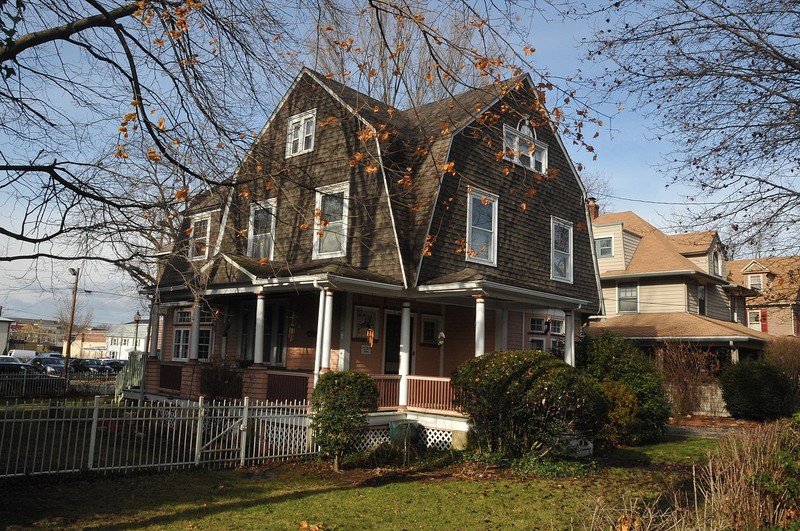Arthur Dorrance House
Introduction
Text-to-speech Audio
Images
2007 photo of the Arthur Dorrance House

Backstory and Context
Text-to-speech Audio
Arthur Dorrance, the originator of Campbell's soups and President of the Joseph Campbell Company from 1894 to 1914, built the historic Colonial Revival home on Franklin Street in 1896. Arthur and Charolotte, his wife, lived in the home from 1896 to 1909. In October of 1895, the Dorrances acquired a parcel of land from Charlotte L. Rowbotham, widow of William Rowbotham. The land served as a small part of a much larger plot of land the Rowbothams had purchased from Matthias Homer, one of Merchantville's founding fathers. But, by the time the Dorrances moved to the town, it had grown into a commuter suburb populated by several wealthy residents, notably on Franklin Street.
Arthur Dorrance (1849-1922), of French-Irish descent, was born and raised in Bristol, Pennsylvania. His father, John Dorrance, gained his wealth as a railroad tycoon, namely by building the first railroad that linked Philadelphia, Camden, and Trenton. After attending Harvard, Arthur and his brother operated a wholesale flour, coal, and feed business in Bristol. In the early 1880s, Walter S. Spackman, a personal friend of Arthur Dorrance and son-in-law of Joseph Campbell, introduced Dorrance to the founder of the Campbell's Soup Company. The company enjoyed tremendous success by the 1880s with its canned tomatoes, mincemeat, vegetables, jams, and many other items. As a result of its growth, Campbell's needed to update and enlarge its equipment and facilities, which led to the relationship with Arthur Dorrance.
Thus, in 1882, Arthur Dorrance partnered with Joseph Campbell, Walter S. Spackman, and Campbell's nephew, Joseph S. Campbell. The company erected a new brick manufacturing plant in Camden. Within seven years, Arthur Dorrance acquired the controlling interest in the company that evolved into the Joseph Campbell Preserve Company. As a result of his personal success, Dorrance moved to a house in Philadelphia with easy access to Camden via the ferries across the river. In 1892, Dorrance, who had been a widower for eight years, married Charlotte A. Boumonville and the new couple moved to Merchantville. Two years later, in 1894, Dorrance succeeded Joseph Campbell as President and then (in 1895-1896) built what is now the historic home on Franklin Avenue in Merchantville.
As company president, Dorrance and Campbell's prospered. In 1897, Dorrance hired his nephew and chemist, Dr. John T. Dorrance, who originated the concept of canned condensed soup for which the company is well known today. Indeed, it was John's innovation that ultimately allowed Arthur to guide the company to its immense success. Dr. Dorrance figured out a method for eliminating the water in canned soup, which lowered the costs for packaging, shipping, and storage. As a result, Campbell's could sell a ten-ounce can of condensed soup for a dime, compared to 30 cents for a typical 32-ounce can of soup; the competitors' cans were bigger and bulkier because they contained more water.
With Arthur Dorrance as president, the company introduced its famous red-and-white soup label, created "Campbell's Kids," and developed ads used on New York streetcars. In 1900, Campbell's Soups won the Gold Medallion for excellence at the Paris Exposition. In 1904, Dorrance's company produced an abundance of soup varieties and sold 16 million cans. Before retiring in 1914, Arthur Dorrance entered Campbell's Soups into the California market and national distribution.
The land purchased by the Dorrances was part of a much bigger parcel of land owned by Matthias Homer, one of the town founders. By the time the Dorrances built on the property, Merchantville had grown into a commuter suburb of the Philadelphia and Camden area, mainly populated by those who enjoyed the financial means to build homes and commute to work. Indeed, many wealthy residents lived in Merchantville. Nearly all the houses on Franklin Avenue arose around the turn of the century and were designed by prominent Camden and Philadelphia architects. Arthur and Charlotte Dorrance lived at 28 Franklin Avenue with Ellen Therese Dorrance (a daughter from his first marriage) and two servants.
Like many industrialists and moguls of the late nineteenth century, Dorrance enjoyed many leisurely activities and participated in clubs and activities. He served as a vestryman in Merchanlville's Episcopal Church and he supported both the Merchantville Field Club (Country Club) and Merchantville Gun Club. After the First World War, Dorrance became heavily involved in Belgian war relief efforts; the Belgian Government presented Dorrance with the King's Medal and Certificate of Generosity.
Dorrance also increased his wealth by investing in several real estate projects, notably as he neared retirement from Campbell's. In roughly 1907 or 1908, Dorrance turned that activity into a personal endeavor when he hired the prominent Merchantville architect, Henry Alexander Macomb, to design his retirement home in Riverton. Dorrance retired from Campbell's in 1914 and died in Riverton on March 12, 1922. The Dorrance has family remained actively involved in the company to this day, and has grown into one of the wealthiest families in the United States.
Sources
Benenson, Carol A., "Merchantville, New Jersey: The Development, Architecture, and Preservation of a Victorian Commuter Suburb"
(1984). Theses (Historic Preservation). 236. https://repository.upenn.edu/cgi/viewcontent.cgi?article=1541&context=hp_theses.
Perloff, Carol Benenson. "Nomination Form: Dorrance, Arthur, House." National Register of Historic Places. nps.gov. March 29, 1994. https://npgallery.nps.gov/GetAsset/d6c5e1e2-9bd0-4095-9f3d-996a6b52742c.
Editorial Staff. "History: Campbell Soup Company." SouthJersey.com. Accessed February 12, 2021.
By Jerrye & Roy Klotz, MD - Own work, CC BY-SA 3.0, https://commons.wikimedia.org/w/index.php?curid=30052037
